10 Best Native Plants for Southern California
BY LAUREN BRYANT | JUNE 6TH, 2023 | CALIFORNIA, LAWN CAREIf you’ve been to the California Botanic Garden or the Santa Barbara Botanic Garden, you know how beautiful native plants can be. Native species are not only well-adapted to the local climate but are also:
- Drought-tolerant
- Easy to care for
- Beneficial to the local ecosystem and wildlife
Do you want to introduce native species to your garden? The best native plants for Southern California gardens will vary by region, as well as the needs and preferences of each homeowner.
In this article, we’ll cover:
- 10 Best Southern California Native Plants
- How to Choose the Best Native Plants for Your Southern California Landscape
- FAQ About Southern California Native Plants
- When to Hire a Pro
10 Best Southern California Native Plants
1. Bush Sunflower (Encelia californica)
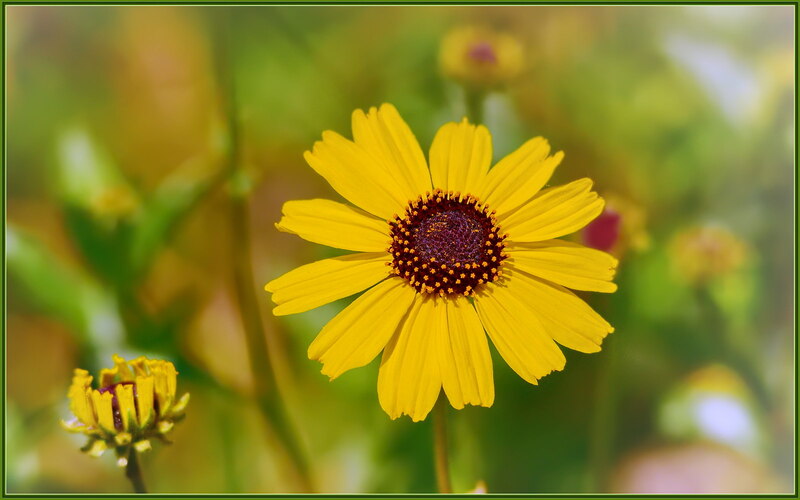
Photo Credit: tdlucas5000 / Flickr / CC BY 2.0
Also known as California brittlebush, this bushy shrub is native to the coastlines and inland foothills of SoCal. It has thin branches with widely spaced leaves. It produces yellow flowers with a brown center, quite similar to daisies. They bloom from February through June when temperatures are moderate, and moisture is adequate.
Bush sunflowers attract small birds, butterflies, bees, and other insects. They are fast-growing, low-maintenance, and drought-tolerant. You also can use them as a ground cover or for erosion control.
While their reseeding ability may save you time and money, bush sunflowers may out-compete other plants and invade spaces where they aren’t wanted. They also don’t look appealing during their late summer and fall dormancy. This shrub does best in sunny yards where temperatures won’t drop below freezing.
Growth habit: Shrub
USDA Hardiness Zone: 7-10
Mature size: 1 ⅗ to 5 feet tall, 3 to 7 feet wide
Duration: Perennial
Foliage: Semi-summer deciduous
Sunlight needs: Full sun
Soil preferences: Tolerates a wide variety of soils, including sodic soil; does best when pH is between 6 and 8
Water needs: Very low
Potential hazards: None known
2. California Fuchsia (Epilobium canum)
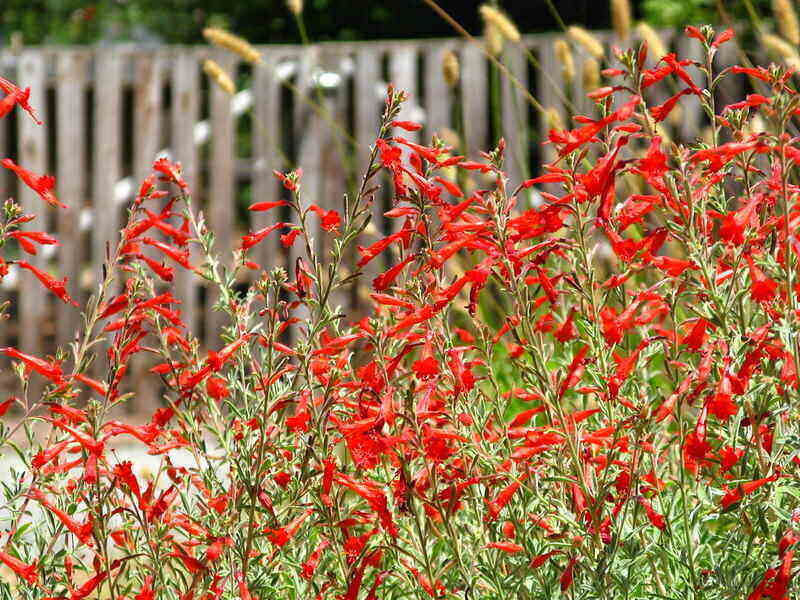
Photo Credit: chuck b. / Flickr / CC BY 2.0
You can find this flower all over California, right up to the Oregon and Mexican borders. It naturally grows on the coast and all over the foothills. In Southern California, it often grows near water sources to counteract the dry climate. California fuchsia produces red flowers in summer and fall, then dies back in winter.
If you want to attract hummingbirds, this plant is a must-have. Their affinity for the plant has earned it the alternate names hummingbird trumpet or flower. It’s easy to grow, reseeds itself, and flowers profusely in full sun. It’s also included on some fire-resistant plant lists.
Unless it is near a natural water source, California fuchsia will need more supplemental water inland than on the coast. Water it around once a month to keep it hydrated. This herb’s appearance will suffer somewhat in fall or winter when flowering is over. You can improve its appearance by cutting it back when flowering is over.
Growth habit: Herb
USDA Hardiness Zone: 7-10
Mature size: ¼ to 1 ½ feet tall and 2 to 3 feet wide
Duration: Perennial
Foliage: Winter semi-deciduous
Sunlight needs: Full sun or partial shade
Soil preferences: Clay and sand with a pH between 6 and 8; they also tolerate serpentine soils
Water needs: Very low
Potential hazards: Non-toxic
3. California Milkweed (Asclepias californica)
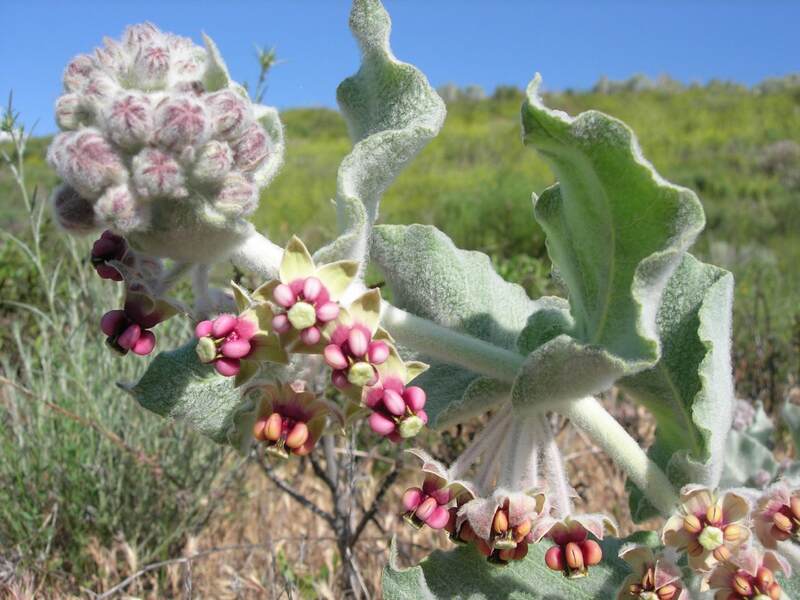
Photo Credit: Joe Decruyenaere / Wikimedia Commons / CC BY-SA 2.0
Named for its white sap, the California milkweed is an herbaceous plant found from the East Bay down and in the Sierra foothills. It has white wooly stems, and its fuzzy buds burst into star-shaped flowers.
California milkweed’s most important role is hosting endangered monarch butterflies and caterpillars. As a result, avoid pesticides to keep these butterflies safe. California milkweed also attracts bees and other insects. This plant can tolerate sandy, clay, dry, or moist soils and is cold-hardy as low as 5 degrees Fahrenheit. Water it deeply twice a month to keep it healthy.
The Kawaiisu tribes cooked California milkweed sap to create a gum-like candy and roasted the leaves for chewing. Though it is edible to humans when cooked, it may be toxic raw. It’s safest to keep this plant away from children, pets, and livestock.
Growth habit: Herb
USDA Hardiness Zone: 7-10
Mature size: 3 feet tall and 3 feet wide
Duration: Perennial
Foliage: Summer semi-deciduous
Sunlight needs: Full sun
Soil preferences: Sandy or clay with a pH between 6 and 8
Water needs: Low
Potential hazards: Toxic raw, but not when cooked
4. California Poppy (Eschscholzia californica)
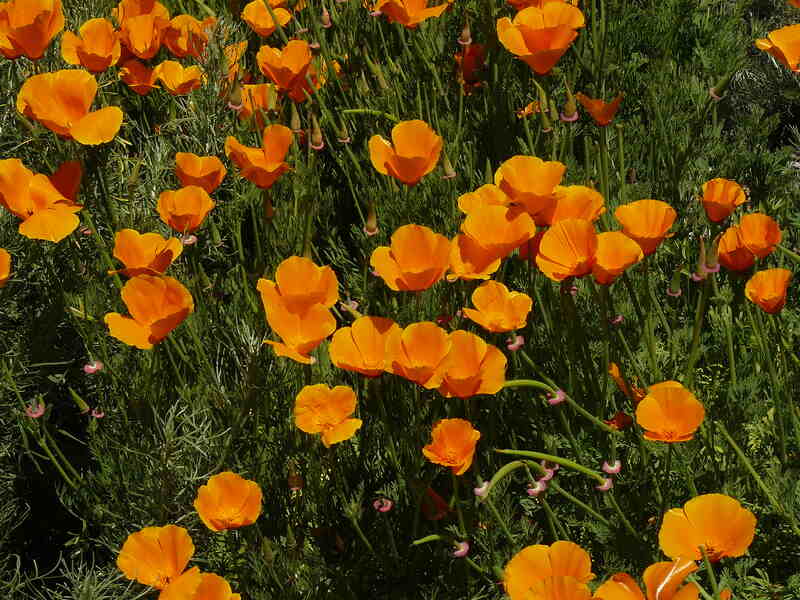
Photo Credit: docentjoyce / Flickr / CC BY 2.0
It’s no surprise the state flower made it onto this list. The California poppy grows all over the state and in neighboring states as well, including Oregon. Its appearance varies slightly depending on location, with SoCal poppies more yellow than orange. The flowers can bloom any time between February and September, though they shut in cold, cloudy, or windy weather.
California poppies can tolerate poor-quality soil, full sun, partial shade, and drought. They will do best in well-drained sandy soils. Water twice a month once established. This flower makes a welcome addition to butterfly, bee, or bird gardens. Its quick-growing and self-seeding nature may spread it more than you intended but can create a beautiful meadow in your yard.
Though California poppies will generally last for years, they may burn out quicker in the hottest and coldest parts of Southern California. Poppies aren’t safe for pets or small children to eat due to their mild toxicity.
Growth habit: Herb or flower
USDA Hardiness Zone: 6-10
Mature size: 2 inches to 2 feet tall and 1 to 2 feet wide
Duration: Perennial in mild climates and annual in harsh conditions
Foliage: Summer deciduous
Sunlight needs: Full sun or partial shade
Soil preferences: Well-drained sandy soils with a pH between 5 and 8; tolerates poor soil quality
Water needs: Very low
Potential hazards: Mildly toxic if ingested
5. California Sagebrush (Artemisia californica)
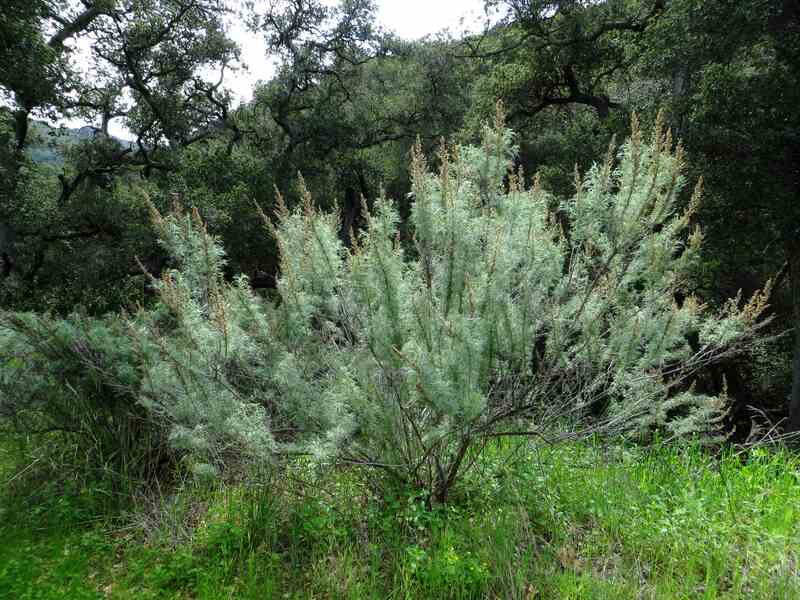
Photo Credit: Antandrus / Wikimedia Commons / CC BY-SA 3.0
Do you love aromatic plants? The hairy, light green leaves of the California sagebrush release a pleasant smell when touched. It produces small, inconspicuous creamy white flowers. This shrub is also called Coastal sagebrush due to its prominence along the California coastline.
California sagebrush is tough, easy to grow, and drought-tolerant. It can survive in the driest, sunniest areas where other plants can’t. It may not need any supplementary water, but you can water it once a month if needed. Use it as a garden shrub or a groundcover. You also can plant it to attract California gnatcatchers, quails, and many other birds and insects.
This shrub poses no known danger to humans or animals. However, rain may leach toxins from California sagebrush and discourage other plant growth nearby.
Growth habit: Shrub
USDA Hardiness Zone: 7-9
Mature size: 1 to 8 feet tall and 4 feet wide
Duration: Perennial
Foliage: Summer deciduous
Sunlight needs: Full sun
Soil preferences: Dry, sandy soils with a pH of 5 to 8; tolerates low fertility and clay soils
Water needs: Extremely low
Potential hazards: Some toxicity toward other plants, but no known danger to humans or pets
6. Chalk Dudleya (Dudleya pulverulenta)
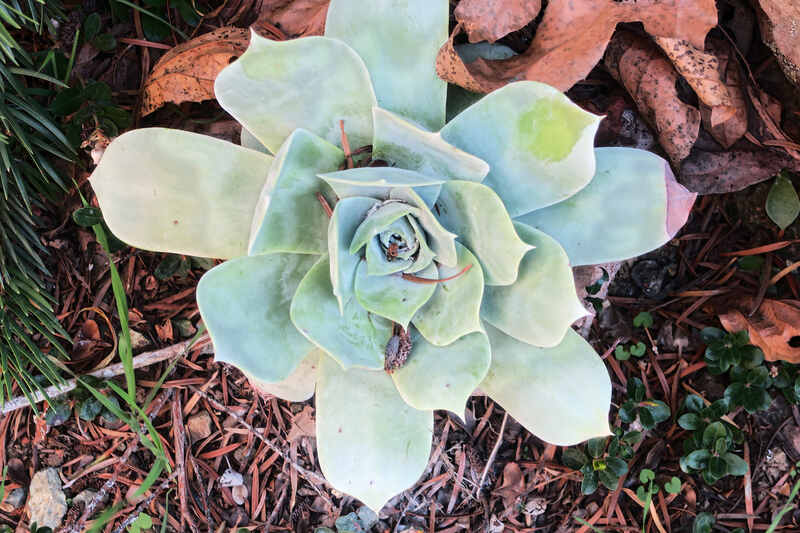
Photo Credit: John Rusk / Flickr / CC BY 2.0
If you’re a fan of succulents, consider chalk dudleya. You also may know it by the names chalk liveforever or chalk lettuce. It naturally grows in rocky coastal areas, desert foothills, and inland mountains. Its thick, water-dense leaves are pale green with pointy ends. Though its shape may look flower-like, the real flowers will develop on tall stems in spring.
This succulent relies on hummingbirds and bees for pollination. When mature, it can handle extreme heat and below-freezing temperatures. Chalk dudleya does well in full sun, but south-facing specimens benefit from partial shade. Don’t panic if the outer leaves turn white, tan, pink, or purple. As long as the inside looks alive, it’s likely just dormant. Water it once a month to improve its appearance.
Chalk dudleya is easy to grow on rocky slopes and walls but not when planted on flat ground because it collects too much water. Watch out for aphid infestations, as they could cause deformity.
Growth habit: Herb or succulent
USDA Hardiness Zone: 7-10
Mature size: ⅓ to 1 foot tall and 1 foot wide
Duration: Perennial
Foliage: Summer deciduous
Sunlight needs: Full sun or partial shade
Soil preferences: Fast or medium-drained soils with plenty of rocks and a soil pH between 5 and 8
Water needs: Very low
Potential hazards: None known
7. Checker Bloom (Sidalcea malviflora)
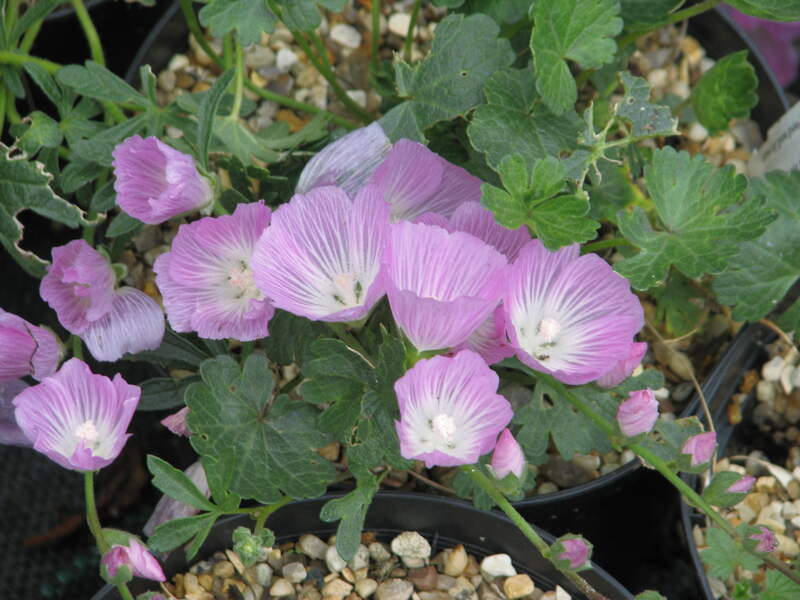
Photo Credit: peganum / Flickr / CC BY-SA 2.0
The checker bloom is a type of mallow found all over the state. It primarily grows in dry, open flats between sea level and 7,500 feet elevation. This plant has bright green leaves and produces dark pink flowers in spring and summer.
Checker bloom is suitable for ornamental and pollinator gardens. You also can use it as a groundcover. It needs little water and can get by with water once a month or less in summer. You can plant it in a variety of soil types in sunny or partially shady yards.
Mild, damp winters and dry, cool summers best suit this plant. However, it can survive in temperatures as low as -15 degrees Fahrenheit. If you live in a colder part of SoCal, you can use mulch to protect checker bloom from freezing temperatures. Because of its short stature, you’ll need to place it in front of tall plants so it’s not obscured.
Growth habit: Herb
USDA Hardiness Zone: 6a-10b
Mature size: ⅓ to 1 ½ feet tall and 3 to 6 feet wide
Duration: Perennial
Foliage: Summer semi-deciduous
Sunlight needs: Full sun or partial shade
Soil preferences: Tolerates many soil types with a pH between 6 and 7, including serpentine soil
Water needs: Low
Potential hazards: Non-toxic and edible
8. Cleveland Sage (Salvia clevelandii)
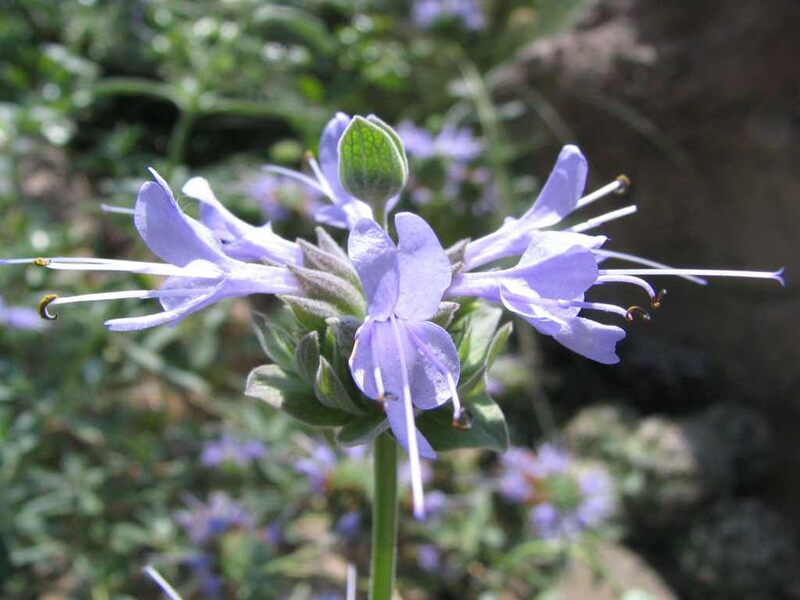
Photo Credit: Phyzome / Flickr / CC BY-SA 3.0
Despite what the name implies, Cleveland sage is native to the Golden State. It is also called blue sage, fragrant sage, or chaparral sage. Its natural habitat is well-drained flats, bluffs, and gentle slopes in coastal areas. This aromatic shrub is gray-green in color with small, wrinkled leaves. It produces round purple flower clusters in spring and summer. Flower color varies between cultivars.
Cleveland sage is a great choice for hummingbird and bee gardens. It’s not just useful for animals — dry its fragrant leaves for cooking or just to enjoy the scent. This shrub can handle many soil types and temperatures as low as 20 degrees Fahrenheit. Plant it as an ornamental plant or for erosion control.
This plant needs very little irrigation. While this trait is generally beneficial, it’s possible to overwater Cleveland sage in summer, killing it or shortening its lifespan.
Growth habit: Shrub
USDA Hardiness Zone: 8-11
Mature size: 3 to 4 ½ feet tall and 8 feet wide
Duration: Perennial
Foliage: Evergreen
Sunlight needs: Full sun or partial shade
Soil preferences: Tolerates a variety of soils but does best in well-drained soils with a pH between 6 and 8
Water needs: Very low
Potential hazards: None known
9. Hummingbird Sage (Salvia spathacea)
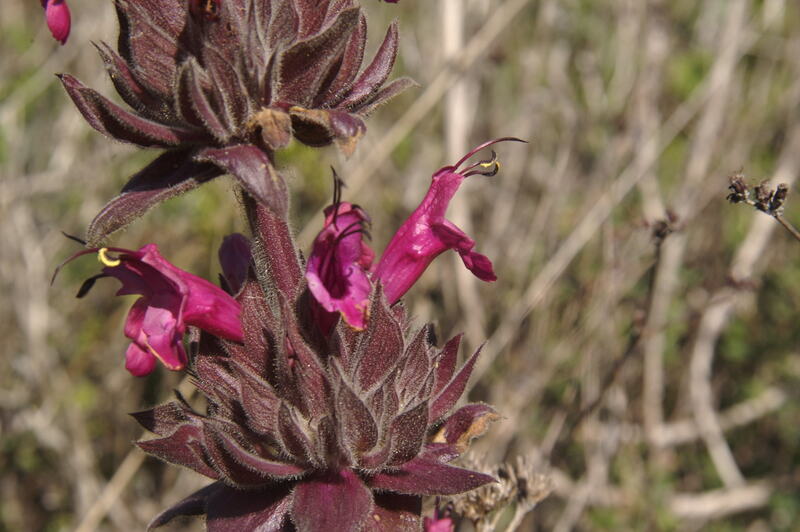
Photo Credit: Jerry Kirkhart / Flickr / CC BY 2.0
Hummingbird sage is native to Central and Southern California. It grows anywhere between sea level and 2,000 feet but is mostly found on shady slopes, chaparral, and coastal sage scrub. This plant has a woody base and is covered with soft hairs. It produces fragrant magenta flowers from March to May. Its leaves also are aromatic when crushed.
Hummingbird sage is valued for its appearance and scent. Hummingbirds, bees, and butterflies flock to its flowers as a food source. Because of its sprawling growth habit, you can use it as a groundcover. It can handle sun or shade but does particularly well under dense tree cover. Hummingbird sage can handle temperatures as low as 0 degrees Fahrenheit.
This plant is drought-tolerant and may not need supplemental irrigation after its first year. However, it may lose some leaves and visual appeal in summer. Water hummingbird sage once or twice a month to keep it green in hot weather, and prune it if you want a neater appearance.
Growth habit: Herb
USDA Hardiness Zone: 7b-10b
Mature size: 4 inches to 3 feet tall
Duration: Perennial
Foliage: Evergreen
Sunlight needs: Full sun, partial shade, or full shade
Soil preferences: Various soils with a pH between 5 and 7
Water needs: Very low
Potential hazards: Non-toxic
10. Bush Monkey Flower (Diplacus aurantiacus)
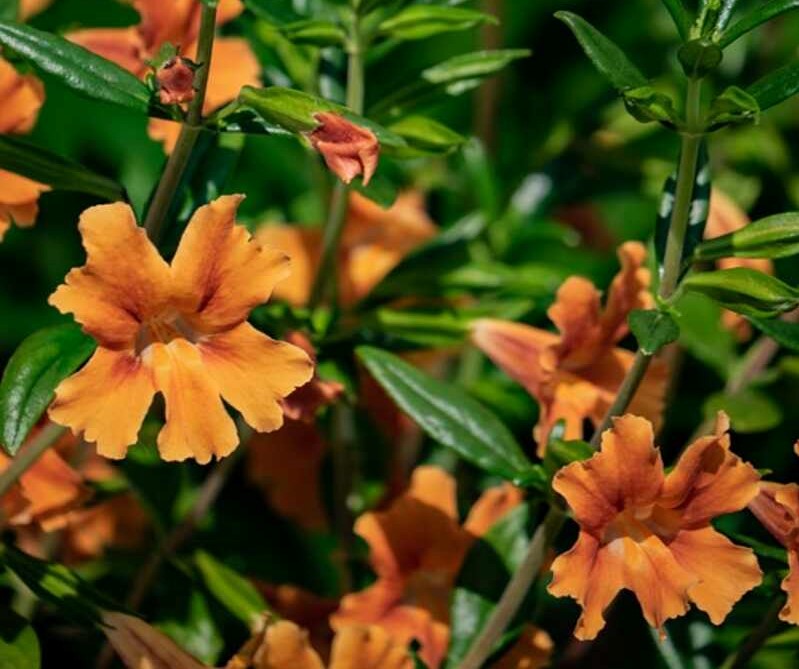
Photo Credit: Pixabay
Monkeys may not be native to California, but monkey flowers are. The bush monkey flower grows throughout most of California. It’s also called sticky monkey flower due to its sticky green leaves. Its tubular flowers are typically orange but also may be white, yellow, or red. If you or a pollinator touch the flower’s stigma, it will shut.
Bush monkey flowers will attract hummingbirds, bees, and other insects. The leaves and flowers are edible, and Native Americans used them for medicinal purposes. Once established, water it once or twice a month in summer.
If you want to increase flower production and get rid of unappealing faded blooms, prune the old growth and seedheads. Be careful not to cut off buds in the process.
Growth habit: Shrub
USDA Hardiness Zone: 8a-10b
Mature size: 4 to 5 feet tall and 5 feet wide
Duration: Perennial
Foliage: Evergreen
Sunlight needs: Full sun or partial shade
Soil preferences: Tolerates many soil types, including serpentine soils, as long as drainage is adequate; ideal pH is between 5 and 8
Water needs: Very low
Potential hazards: Non-toxic and edible
How to Choose the Best Native Plants for Your Southern California Landscape
People from out of state may only see SoCal as sunny coastlines, but residents know there’s more to it. A Southern Californian may live by the beach, mountains, or desert, and each will have its own gardening challenges. Focus on plants that fall in your USDA hardiness zone, which is based on average annual low temperatures. SoCal falls in zones 7 through 10.
USDA hardiness zones can’t tell you everything. They don’t account for your yard’s layout, soil makeup, shade levels, and proximity to water sources. Consider getting a soil test, especially if your garden plants have struggled in the past. University of California Cooperative Extensions can connect you with local soil testing labs.
The final factor to consider is you. Consider what features you value, whether it be visual appeal, scent, drought tolerance, safety, or practicality.
FAQ About Southern California Native Plants
For erosion control or bank stabilization, consider planting bush sunflower or Cleveland sage.
Yes. Chalk dudleya is one of the best choices for SoCal, but there are hundreds of other succulents native to the state.
It depends on where you are and which succulents you plant. Southern California generally has mild winters. While some cities may never see a day below 40 degrees, a few places in SoCal have temperatures below freezing and could get as low as 0 degrees Fahrenheit.
Some succulents, like chalk dudleya, can survive freezing temperatures. However, others are more sensitive and may not survive a cold snap. If you see an unusual temperature drop on your weather channel or app, you can take in any potted succulents, just in case.
Keep in mind that your succulents will get more rain in winter as well. Don’t water them yourself this time of year, and make sure they are in well-drained soil.
When to Hire a Pro
It’s easy enough to swing by your local nursery for one or two native plants. However, some homeowners choose to transform their yards into entirely native gardens. They also might replace their lawn with a more suitable turfgrass for improved drought resistance.
The more changes you make, the more time you’ll need to commit. Even the most passionate green thumb may need a helping hand. Wikilawn can connect you with landscaping and lawn care professionals in your area, whether you live in San Diego, Los Angeles, Long Beach, or another SoCal city.